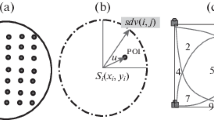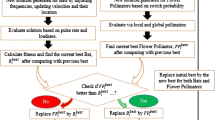Abstract
Minimum energy broadcast (MEB) problem in wireless sensor network has attracted attentions of the many researchers due to the limited bandwidth of the network and battery life of the sensor nodes. The data in a wireless network are transmitted from the source node to all other nodes and seek broadcast scheme to transmit with minimum energy consumption. The main objective of MEB is to minimize the transmission energy consumption of the network and is considered as an NP-complete problem. This work proposes a new variant of Flower pollination algorithm based on Powell’s method (PFPA) to solve MEB problem in wireless sensor networks. The proposed algorithm is compared with other heuristic approaches and the performance of the algorithm is assessed using benchmark instances with 50 and 100 nodes. The effectiveness and merit of the proposed algorithm is demonstrated in terms of performance metrics.




Similar content being viewed by others
References
Al-Shihabi, S., Merz, P., & Wolf, S. (2007). Nested partitioning for the minimum energy broadcast problem. International conference on learning and intelligent optimization (pp. 1–11). Berlin Heidelberg: Springer.
Arivudainambi, D., & Rekha, D. (2013). Memetic algorithm for minimum energy broadcast problem in wireless ad hoc networks. Swarm and Evolutionary Computation, 12, 57–64.
Bauer, J., Haugland, D., & Yuan, D. (2009). A fast local search method for minimum energy broadcast in wireless ad hoc networks. Operations Research Letters, 37(2), 75–79.
Bekdaş, G., Nigdeli, S. M., & Yang, X.-S. (2015). Sizing optimization of truss structures using flower pollination algorithm. Applied Soft Computing, 37, 322–331.
Čagalj, M., Hubaux, J.-P., & Enz, C. (2002). Minimum-energy broadcast in all-wireless networks: NP-completeness and distribution issues. In Proceedings of the 8th annual international conference on mobile computing and networking (pp. 172–182). ACM.
Das, A. K., Marks, R. J., El-Sharkawi, M., Arabshahi, P., & Gray, A. (2002). The minimum power broadcast problem in wireless networks: An ant colony system approach. In Proceedings of the IEEE workshop on wireless communications and networking.
Das, A. K., Marks, R. J., El-Sharkawi, M., Arabshahi, P., & Gray, A. (2003). r-shrink: A heuristic for improving minimum power broadcast trees in wireless networks. In Global telecommunications conference, 2003. GLOBECOM'03 (vol. 1, pp. 523–527). IEEE.
Guo, S., & Yang, O. W. W. (2007). Energy-aware multicasting in wireless ad hoc networks: A survey and discussion. Computer Communications, 30(9), 2129–2148.
Guo, S., & Yang, O. (2004). A dynamic multicast tree reconstruction algorithm for minimum-energy multicasting in wireless ad hoc networks. In 2004 IEEE international conference on performance, computing, and communications (pp. 637–642). IEEE.
Hernández, H., & Blum, C. (2009). Ant colony optimization for multicasting in static wireless ad-hoc networks. Swarm Intelligence, 3(2), 125–148.
Hsiao, P.-C., Chiang, T.-C., & Fu, L.-C. (2013). Static and dynamic minimum energy broadcast problem in wireless ad-hoc networks: A PSO-based approach and analysis. Applied Soft Computing, 13(12), 4786–4801.
Jiang, J.-A., Chen, C.-P., Chuang, C. L., Lin, T.-S., Tseng, C.-L., Yang, E.-C., & Wang, Y.-C. (2009). CoCMA: Energy-efficient coverage control in cluster-based wireless sensor networks using a memetic algorithm. Sensors, 9(6), 4918–4940.
Kang, I., & Poovendran, R. (2003). A novel power-efficient broadcast routing algorithm exploiting broadcast efficiency. In Vehicular technology conference, 2003. VTC 2003-fall. 2003 IEEE 58th (vol. 5, pp. 2926–2930). IEEE.
Kang, I., & Poovendran, R. (2004). Broadcast with heterogeneous node capability [wireless ad hoc or sensor networks]. In Global telecommunications conference, 2004. GLOBECOM'04 (vol. 6, pp. 4114–4119). IEEE.
Kang, I., & Poovendran, R. (2005). Iterated local optimization for minimum energy broadcast. In Third international symposium on modeling and optimization in mobile, ad hoc, and wireless networks, 2005. WIOPT 2005 (pp. 332–341). IEEE.
Khalil, E. A., & Bara’a, A. A. (2011). Energy-aware evolutionary routing protocol for dynamic clustering of wireless sensor networks. Swarm and Evolutionary Computation, 1(4), 195–203.
Klasing, R., Navarra, A., Papadopoulos, A., & Pérennes, A. (2004). Adaptive broadcast consumption (ABC), a new heuristic and new bound for the minimum energy broadcast routing problem. International conference on research in networking (pp. 866–877). Berlin Heidelberg: Springer.
Konstantinidis, A., Yang, K., Chen, H.-H., & Zhang, Q. (2007). Energy-aware topology control for wireless sensor networks using memetic algorithms. Computer Communications, 30(14), 2753–2764.
Konstantinidis, A., Yang, K., Zhang, Q., & Zeinalipour-Yazti, D. (2010). A multi-objective evolutionary algorithm for the deployment and power assignment problem in wireless sensor networks. Computer Networks, 54(6), 960–976.
Liang, W. (2002). Constructing minimum-energy broadcast trees in wireless ad hoc networks. In Proceedings of the 3rd ACM international symposium on mobile ad hoc networking and computing (pp. 112–122). ACM.
Mantegna, R. N. (1994). Fast, accurate algorithm for numerical simulation of Levy stable stochastic processes. Physical Review E, 49(5), 4677.
Miller, C., & Poellabauer, C. (2009). A decentralized approach to minimum-energy broadcasting in static ad hoc networks. International conference on ad-hoc networks and wireless (pp. 298–311). Berlin Heidelberg: Springer.
Molina, G., & Alba, E. (2011). Location discovery in wireless sensor networks using metaheuristics. Applied Soft Computing, 11(1), 1223–1240.
Montemanni, R., Gambardella, L. M., & Das, A. K. (2005). The minimum power broadcast problem in wireless networks: A simulated annealing approach. In Wireless communications and networking conference, 2005 IEEE (vol. 4, pp. 2057–2062).
Pavlyukevich, I. (2007). Lévy flights, non-local search and simulated annealing. Journal of Computational Physics, 226(2), 1830–1844.
Powell, M. J. D. (1977). Restart procedures for the conjugate gradient method. Mathematical Programming, 12(1), 241–254.
Rajeswari, M., Amudhavel, J., Pothula, S., & Dhavachelvan, P. (2017). Directed bee colony optimization algorithm to solve the nurse rostering problem. Computational Intelligence and Neuroscience, 2017, 26. https://doi.org/10.1155/2017/6563498.
Raju, R., Amudhavel, J., Kannan, N., & Monisha, M. (2014). A bio inspired energy-aware multi objective chiropteran algorithm (EAMOCA) for hybrid cloud computing environment. In 2014 International conference on green computing communication and electrical engineering (ICGCCEE) (pp. 1–5). IEEE.
Reynolds, A. M., & Frye, M. A. (2007). Free-flight odor tracking in Drosophila is consistent with an optimal intermittent scale-free search. PLoS ONE, 2(4), e354.
Sengupta, S., Das, S., Nasir, M. D., & Panigrahi, B. K. (2013). Multi-objective node deployment in WSNs: In search of an optimal trade-off among coverage, lifetime, energy consumption, and connectivity. Engineering Applications of Artificial Intelligence, 26(1), 405–416.
Singh, A., & Bhukya, W. N. (2011). A hybrid genetic algorithm for the minimum energy broadcast problem in wireless ad hoc networks. Applied Soft Computing, 11(1), 667–674.
Wan, P.-J., Călinescu, G., Li, X.-Y., & Frieder, O. (2002). Minimum-energy broadcasting in static ad hoc wireless networks. Wireless Networks, 8(6), 607–617.
Wieselthier, J. E., Nguyen, G. D., & Ephremides, A. (2000). On the construction of energy-efficient broadcast and multicast trees in wireless networks. In INFOCOM 2000. Nineteenth annual joint conference of the IEEE computer and communications societies. Proceedings (vol. 2, pp. 585–594). IEEE.
Wolf, S., & Merz, P. (2008). Evolutionary local search for the minimum energy broadcast problem. European conference on evolutionary computation in combinatorial optimization (pp. 61–72). Berlin Heidelberg: Springer.
Wu, X., Wang, X., & Liu, R. (2008). Solving minimum power broadcast problem in wireless ad-hoc networks using genetic algorithm. In Communication networks and services research conference, 2008. CNSR 2008. 6th annual (pp. 203–207). IEEE.
Yang, X.-S. (2012). Flower pollination algorithm for global optimization. International conference on unconventional computing and natural computation (pp. 240–249). Berlin Heidelberg: Springer.
Acknowledgements
This work is a part of the Research Projects sponsored by the Major Project Scheme, UGC, India, Reference Nos: F.No./2014-15/NFO-2014-15-OBC-PON-3843/(SA-III/WEBSITE), dated March 2015. The authors would like to express their thanks for the financial supports offered by the Sponsored Agency.
Author information
Authors and Affiliations
Corresponding author
Additional information
Publisher's Note
Springer Nature remains neutral with regard to jurisdictional claims in published maps and institutional affiliations.
Rights and permissions
About this article
Cite this article
Rajeswari, M., Thirugnanasambandam, K., Raghav, R.S. et al. Flower Pollination Algorithm with Powell’s Method for the Minimum Energy Broadcast Problem in Wireless Sensor Network. Wireless Pers Commun 119, 1111–1135 (2021). https://doi.org/10.1007/s11277-021-08253-1
Accepted:
Published:
Issue Date:
DOI: https://doi.org/10.1007/s11277-021-08253-1




